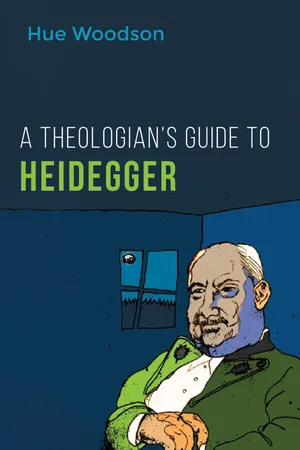![]()
CHAPTER 1: HEIDEGGER’S THEOLOGICAL ROOTS
Heidegger’s Theological Roots
While, from 1903 to 1906, when attending the State Gymnasium in Constance, and subsequently, from 1906 to 1909, when attending the State Berthold Gymnasium in Freiburg, Heidegger remained “with residence at the archdiocesan Gymnasium Seminary in preparation for archdiocesan priesthood.” By July 13, 1909, when he was awarded his high school baccalaureate “with the highest possible overall grade,” having studied a variety of academic subjects including religion, Latin, Hebrew, Greek, and philosophy, Heidegger selected theology on a “statement of intent regarding university studies.” As a student entering the University of Freiburg, Heidegger’s academic “theological roots,” as I refer to them, can be situated in his acceptance into Freiburg’s Department of Theology for the Winter 1909/1910 semester. At that time, Heidegger was still preparing for archdiocesan priesthood, “with residence at the archdiocesan Theological Seminary.”
With the exception of a course on logic, during Heidegger’s first semester at Freiburg, as detailed in noteworthy accounts by Thomas Sheehan (1988) and John Van Buren (2002), Heidegger was enrolled in the following theology/religion courses with the following lecturers: “Encyclopedia of Theological Disciplines” (Rev. Julius Mayer), “Introduction to the Sacred Scripture of the Old Testament” (Rev. Gottfried Hoberg), “Exegesis of Paul’s Letter to the Romans” (Rev. Simon Weber), “General History of the Church, Part One” (Rev. Georg Pfeilschifter), and “Theory of Religion” (Rev. Heinrich Straubinger).
With the exception of a course on metaphysics, in Heidegger’s second semester at Freiburg in Summer 1910, he was enrolled in the following theology/religion courses with the following lecturers: “Messianic Prophesies” (with Hoberg), Hermeneutics, with the History of Exegesis (with Hoberg), “Introduction to the Sacred Scripture of the New Testament” (with Weber), “General History of the Church, Part Two” (with Pfeilschifter), and “Theory of Revelation and of the Church” (with Straubinger).
With the exception of a survey course on the history of the German constitution, in his third semester at Freiburg in Winter 1910/1911, Heidegger was enrolled in the following theology/religion courses with the following lecturers: “Introduction to Catholic Dogmatics: The Doctrine of God” (Rev. Carl Braig), “Exegesis of the Holy Gospel According to John” (with Weber), “General Moral Theology, Part One through Three” (with Mayer), “The Doctrine of Property” (with Mayer), “Catholic Canon Law, Part One: Introduction, Sources, and Constitution” (Rev. Emil Göller), “General History of the Church, Part Three, The Age of the Enlightenment” (with Pfeilschifter), and “The History of Medieval Mysticism” (Rev. Joseph Sauer).
With the exception of a course on the Renaissance, in his fourth semester at Freiburg in Summer 1911, Heidegger was enrolled in the following theology/religion courses with the following lecturers: “Theological Cosmology: The Creation, Preservation, and Governance of the World” (with Braig), “Special Moral Theology, Parts One and Two (with Mayer), and “The Christian Art of the Nineteenth Century and the Present” (with Sauer).
As noted by Sheehan, throughout the Summer of 1911, Heidegger suffered from ill-health that posed “negative consequences for his ecclesiastical plans.” By Fall of 1911, Sheehan observes that “when [Heidegger] returned to Freiburg [for the upcoming Winter 1911 semester], Heidegger had moved out of the theological seminary [ . . . ] he had also transferred out of theology.” Essentially, at this point, Heidegger “abandon[ed] career plans for the priesthood.” It seems that this was mostly due to Heidegger’s “preference at this point [being] to study with Husserl,” who, at the time, was teaching at the University of Göttingen. Instead of doing so, Heidegger was accepted into Freiburg’s Department of Natural Sciences and Mathematics in Winter 1911/1912. Though Heidegger was enrolled mostly math and sciences courses for the semester, with the exception of two science courses and two philosophy courses, it has been detailed by both Sheehan and Van Buren that, during this semester, Heidegger audited a three theology/religion courses with the following lecturers: “Dogmatic Theology” (with Braig), “Gospel of John” (with Prof. Edward Schwartz), and “Hellenic Mystery Religions” (with Prof. Richard Reitzenstein). For the following Summer 1912, Winter 1912/1913, and Summer 1913, Heidegger was enrolled in mostly math courses, with a single science course and a handful of philosophy courses sprinkled throughout. On July 26, 1913, Heidegger had left the Department of Natural Sciences and Mathematics, was accepted to the Department of Philosophy, and was recommended by the Department of Philosophy “for the doctoral degree in philosophy summa cum laude,” based on his dissertation, submitted a month prior, “Theory of Judgment in Psychologism: Critical and Positive Contributions to Logic.” On August 20, 1913, Heidegger applied for a Von Schaezler Grant, in order, as cited by Van Buren, “to dedicate himself to the study of Christian philosophy and to pursue an academic career”—by September 29, 1913, he was awarded the grant for the 1913-1914 academic year with the expectation, as purported by Van Buren, that Heidegger “would remain true to the spirit of Thomistic philosophy.” Heidegger renewed the grant twice (on September 20, 1914 and on December 13, 1915), under the premise that, as Van Buren quotes, “his academic life’s work [would be] oriented to making the wealth of ideas inherited from Scholasticism applicable to the future intellectual struggle for the Christian ideal of life in Catholicism.”...
